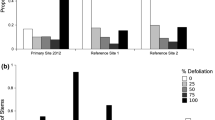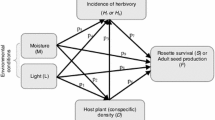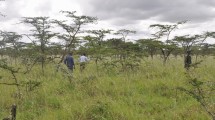Abstract
Spatial pattern and patterns of mortality were analyzed from a five year re-census of over 7000 mapped perennial shrubs within a one hectare study plot in Joshua Tree National Park. A five year interval revealed evidence for negative intraspecific interactions which was not evident after a one year evaluation of the same plants within the study area. Juvenile mortality was a positive function of conspecific density for Ambrosia dumosa, Eriogonum fasciculatum and Sphaeralcea ambigua. In addition, juvenile E. fasciculatum that died occurred closer to conspecific adults than would be expected by chance. The two censuses are similar in that uniform patterns of distribution among conspecifics are rare, particularly for non-succulent species.
These results emphasize the value of mapped study sites in allowing dynamic inferences from otherwise static analyses. Herbivory and nurse effects are implicated as potential factors influencing the dispersion of perennial plants within deserts.
Similar content being viewed by others
References
Anderson, D. J. 1971. Pattern in desert perennials. J. Ecol. 59: 555-560.
Barbour, M. G. 1969. Age and space distribution of the desert shrub Larrea divaricata.Ecology 50: 679-685.
Barbour, M. G. 1973. Desert dogma reexamined: root/shoot productivity and plant spacing. Am. Midland Nat. 89: 41-57.
Beals, E. W. 1968. Spatial pattern of shrubs on a desert plain in Ethiopia. Ecology 49: 744-746.
Bowers, J. E., Webb, R. H., & Rondeau, R. J. 1995. Longevity, recruitment and mortality of desert plants in Grand Canyon, Arizona, USA. J. Veg. Sci. 6: 551-564.
Brown, J. S. 1989. Desert rodent community structure: A test of four mechanisms of coexistence. Ecological Monographs 59(1): 1-20.
Brown, J. S., Kotler, B. P., Smith, R. J. & Wirtz, W. O. II. 1988. The effects of owl predation on the foraging behavior of heteromyid rodents. Oecologia (Berlin) 76: 408-415.
Clark, D. A. & Clark, D. B. 1984. Spacing dynamics of a tropical rain forest tree: evaluation of the Janzen-Connell model. Am. Nat. 124(6): 769-788.
Condit, R., Hubbell, S. P. & Foster, R. B. 1992. Recruitment near conspecific adults and the maintenance of tree and shrub diversity in a neotropical forest. Am. Nat. 140(2): 261-286.
Donnelly, K. P. 1978. Simulations to determine the variance and edge effect of total nearest-neighbor distance. In: Hodder, I. (ed.) Simulation studies in archaeology. Cambridge University Press, Cambridge, England.
Ehleringer, J. R. 1984. Intraspecific competitive effects on water relations, growth and reproduction in Encelia farinosa.Oecologia (Berlin) 63: 153-158.
Franco, A. C. & Nobel, P. S. 1989. Effect of nurse plants on the microhabitat and growth of cacti. J. Ecol. 77: 870-886.
Goldberg, D. E. & Turner, R. M. 1986. Vegetation change and plant demography in permanent plots in the Sonoran Desert. Ecology 67: 695-712.
Greene, L. W. 1983. Historic resource study a history of land use in Joshua Tree National Monument. United States Department of the Interior, National Park Service, Denver Service Center.
Greig-Smith, P. & Chadwick, M. J. 1965. Data on pattern within plant communities. III. Acacia-Capparis semi-desert scrub in the Sudan. J. Ecol. 53: 465-474.
Hamill, D. N. & Wright, S. J. 1986. Testing the dispersion of juveniles relative to adults: a new analytic method. Ecology 67: 952-957.
Howe, H. F. & Wright, S. J. 1986. Spatial pattern and mortality in the desert mallow (Sphaeralcea ambigua). Nat. Geog. Res. 2(4): 491-499.
Hubbell, S. P. 1979. Tree dispersion, abundance, and diversity in a tropical dry forest. Science 203: 1299-1309.
Inouye, R. S., Byers, G. S. & Brown, J. H. 1980. Effects of predation and competition on survivorship, fecundity, and community structure of desert annuals. Ecology 6(16): 1344-1351.
Manning, S. J. & Barbour, M. 1988. Root systems, spatial patterns, and competition for soil moisture between two desert shrubs. Am. J. Bot. 75(6): 885-893.
McAuliffe, J. R. 1986. Herbivore-limited establishment of a Sonoran desert tree, Cercidium microphyllum.Ecology 67(1): 276-280.
McAuliffe, J. R. 1988. Markovian dynamics of simple and complex desert plant communities. Am. Nat. 131(4): 459-490.
McAuliffe, J. R. 1990. Paloverdes, pocket mice and bruchid beetles: Interrelationships of seeds, dispersers, and seed predators. Southwestern Nat. 35(3): 329-327.
Morisita, M. 1959. Measuring the dispersion of individuals and analysis of the distributional patterns. Memoirs of the Faculty of Science, Kyushu University, Series E (Biology) 2(4): 215-235.
Munz, P. A. 1974. A flora of Southern California. University of California Press, Berkeley.
O'Brien, S. T., Hubbell, S. P., Spiro, P., Condit, R. & Foster, R. B. 1995. Diameter, height, crown, and age relationships in eight neotropical tree species. Ecology 76(6): 1926-1939.
Phillips, D. L. & MacMahon, J. A. 1981. Competition and spacing patterns in desert shrubs. J. Ecol. 69: 97-115.
Steenbergh, W. F., & Lowe, C. H. 1977. Ecology of the Saguaro: II. Reproduction, germination, establishment, growth and survival of the young plant. National Park Service Scientific Monograph Series, no. 8. Government Printing Office.
Turner, R.M., Alcorn, S. M., Olin, G. & Booth, J. A. 1966. The influence of shade, soil, and water on Saguaro seedling establishment. Botanical Gazette 127(2-3): 95-102.
Turner, R. M., Alcorn, S. M. & Olin, G. 1969. Mortality of transplanted Saguaro seedlings. Ecology 50: 246-255.
Woodell, S. R., Mooney, H. A. & Hill, A. J. 1969. The behaviour of Larrea divaricata(Creosote bush) in response to rainfall in California. J. Ecol. 57: 37-44.
Wright, S. J. & Howe, H. F. 1987. Pattern and mortality in Colorado Desert plants. Oecologia (Berlin) 73: 543-552.
Author information
Authors and Affiliations
Rights and permissions
About this article
Cite this article
Miriti, M.N., Howe, H.F. & Wright, S.J. Spatial patterns of mortality in a Colorado desert plant community. Plant Ecology 136, 41–51 (1998). https://doi.org/10.1023/A:1009711311970
Issue Date:
DOI: https://doi.org/10.1023/A:1009711311970




